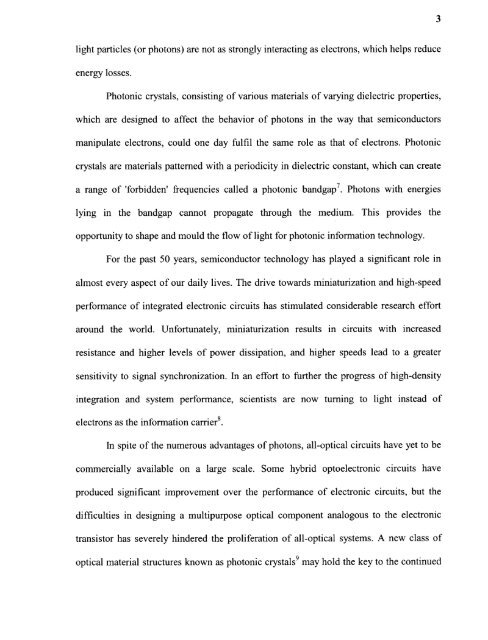Optical properties of photonic crystals - New Jersey Institute of ...
Optical properties of photonic crystals - New Jersey Institute of ...
Optical properties of photonic crystals - New Jersey Institute of ...
Create successful ePaper yourself
Turn your PDF publications into a flip-book with our unique Google optimized e-Paper software.
3<br />
light particles (or photons) are not as strongly interacting as electrons, which helps reduce<br />
energy losses.<br />
Photonic <strong>crystals</strong>, consisting <strong>of</strong> various materials <strong>of</strong> varying dielectric <strong>properties</strong>,<br />
which are designed to affect the behavior <strong>of</strong> photons in the way that semiconductors<br />
manipulate electrons, could one day fulfil the same role as that <strong>of</strong> electrons. Photonic<br />
<strong>crystals</strong> are materials patterned with a periodicity in dielectric constant, which can create<br />
a range <strong>of</strong> 'forbidden' frequencies called a <strong>photonic</strong> bandgap 7. Photons with energies<br />
lying in the bandgap cannot propagate through the medium. This provides the<br />
opportunity to shape and mould the flow <strong>of</strong> light for <strong>photonic</strong> information technology.<br />
For the past 50 years, semiconductor technology has played a significant role in<br />
almost every aspect <strong>of</strong> our daily lives. The drive towards miniaturization and high-speed<br />
performance <strong>of</strong> integrated electronic circuits has stimulated considerable research effort<br />
around the world. Unfortunately, miniaturization results in circuits with increased<br />
resistance and higher levels <strong>of</strong> power dissipation, and higher speeds lead to a greater<br />
sensitivity to signal synchronization. In an effort to further the progress <strong>of</strong> high-density<br />
integration and system performance, scientists are now turning to light instead <strong>of</strong><br />
electrons as the information carrier ^8.<br />
In spite <strong>of</strong> the numerous advantages <strong>of</strong> photons, all-optical circuits have yet to be<br />
commercially available on a large scale. Some hybrid optoelectronic circuits have<br />
produced significant improvement over the performance <strong>of</strong> electronic circuits, but the<br />
difficulties in designing a multipurpose optical component analogous to the electronic<br />
transistor has severely hindered the proliferation <strong>of</strong> all-optical systems. A new class <strong>of</strong><br />
optical material structures known as <strong>photonic</strong> <strong>crystals</strong> 9 may hold the key to the continued
















